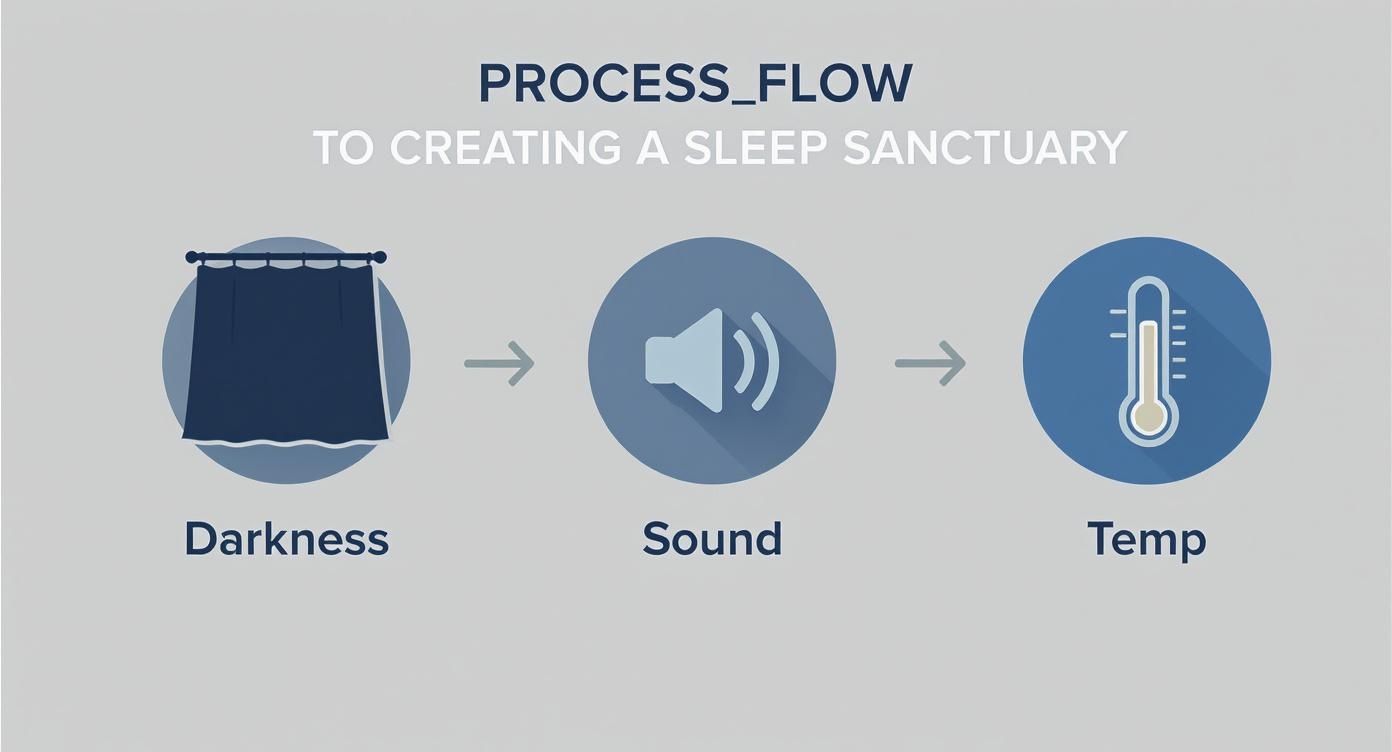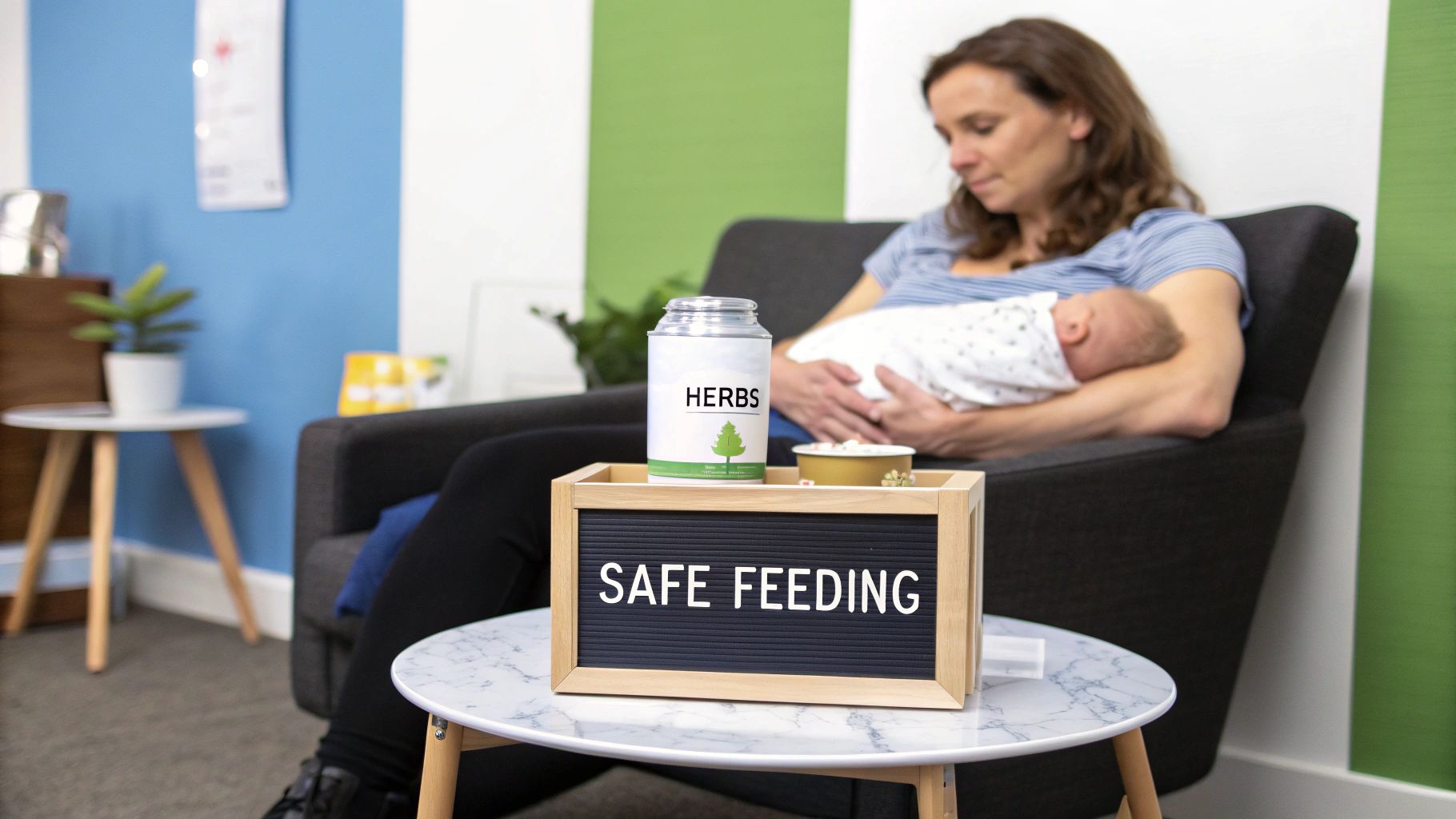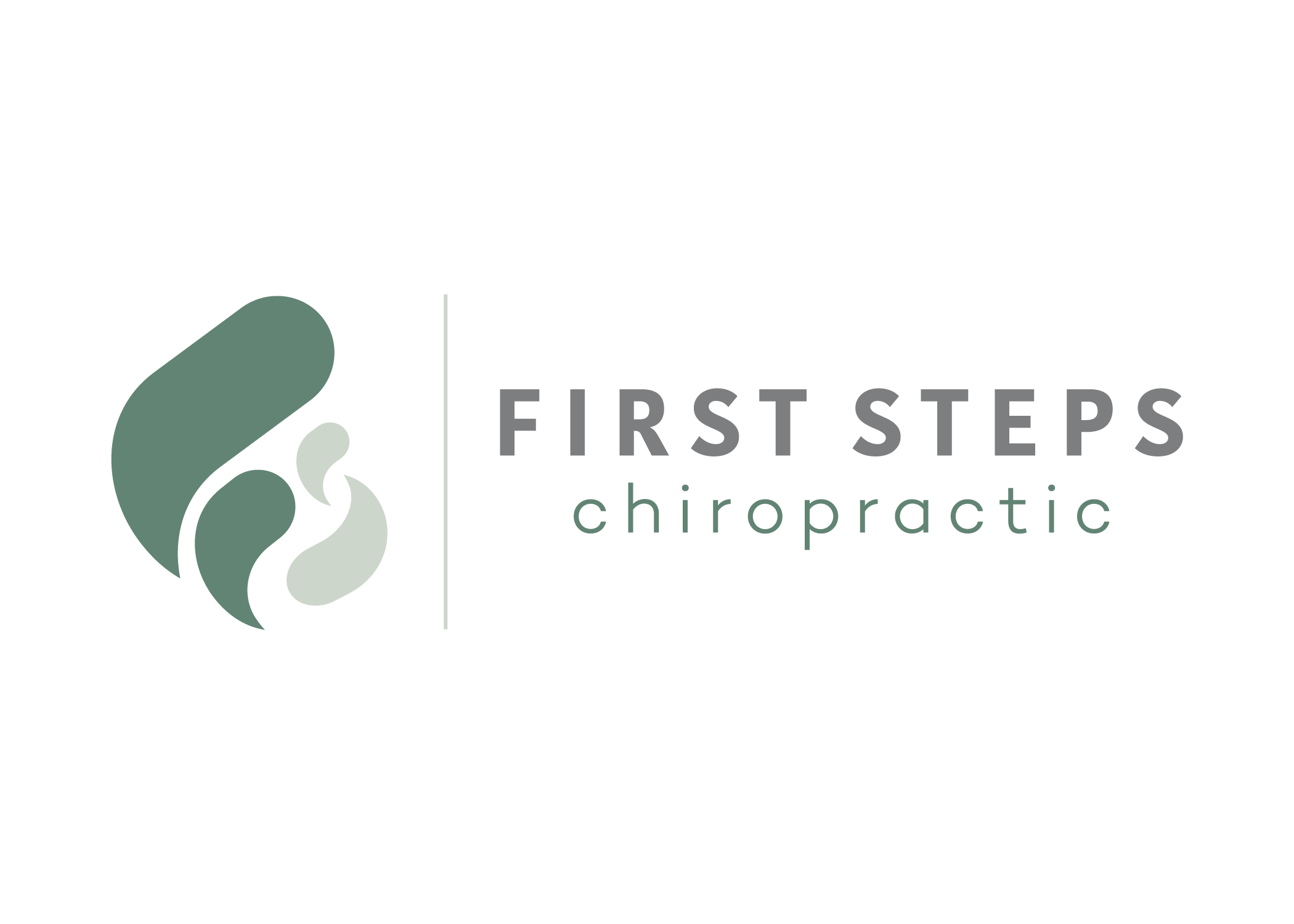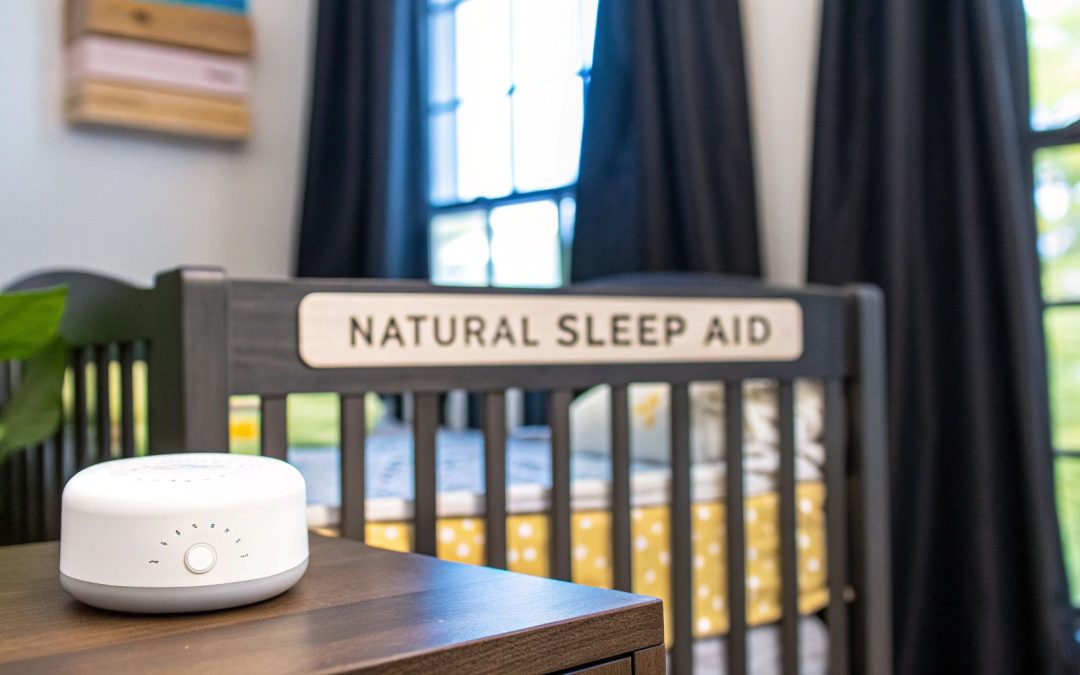Before you even start Googling natural sleep products for your baby, let’s talk about their environment first. Honestly, the most powerful tools for better sleep are often simple tweaks to your baby's room that recreate the dark, quiet, and comforting feeling of the womb.
These core elements—darkness, sound, and temperature—are the foundation. They work together to calm your baby's still-developing nervous system and give their brain the right cues for rest.
Crafting a Womb-Like Sleep Sanctuary
Think about it: the shift from the womb to the outside world is a massive change for a newborn. Inside, it was always dark, consistently warm, and filled with the constant, muffled sounds of mom’s body. When we thoughtfully recreate these elements in the nursery, we're creating a powerful, natural sleep aid that costs very little but can deliver incredible results.
This isn't about buying a bunch of expensive gadgets. It’s about tapping into your baby’s biological needs. A calming, predictable environment helps regulate their internal clock, making it so much easier for them to fall asleep and, more importantly, stay asleep.
Mastering the Art of Darkness
For a brand-new baby, there’s no real difference between day and night. Their circadian rhythm—that internal 24-hour clock that tells us when to be sleepy and when to be awake—is completely undeveloped. This is where complete darkness becomes your best friend in helping them figure it all out.
When light hits the eyelids, it sends a direct signal to the brain to stop producing melatonin, the hormone that makes us all feel sleepy. Even a tiny sliver of light from under the door or a streetlamp outside can be enough to mess with this process and interrupt deep, restorative sleep.
A truly dark room can be an absolute game-changer. You're aiming for a "cave-like" vibe where you can't see your hand in front of your face. This tells your baby's brain that it's time for rest, whether it's 2 PM for a nap or 2 AM.
Getting to that level of darkness usually requires more than just standard blinds. It’s worth investing in high-quality blackout curtains that wrap around the window frame. You can also use temporary fixes like blackout window film. The goal is simple: eliminate every last bit of external light.
Harnessing the Power of Consistent Sound
The womb is anything but silent. Your baby is used to the constant whoosh of blood flow, the rhythmic beat of a heart, and all sorts of other muffled sounds. An overly quiet room can actually feel unsettling and makes them jump at every little household noise, like a dog barking or a sibling slamming a door.
A continuous white noise machine is a fantastic way to mimic this auditory environment. It creates a steady, soothing soundscape that effectively masks those sudden, disruptive noises.
When using a sound machine, here are a few tips to keep in mind:
- Keep it consistent: The sound should run continuously through every nap and all night long.
- Place it safely: The machine should always be several feet away from the crib, never inside it.
- Maintain a safe volume: Keep the sound no louder than a soft shower, which is right around 50 decibels.
Some babies are just more sensitive to their surroundings, and understanding their unique wiring is crucial. For little ones who seem easily overstimulated, learning more about the signs of sensory issues in infants can offer some really valuable insights into creating an even more supportive sleep space for them.
Using Gentle Touch and Rhythmic Motion
Once you’ve set the stage with a calming environment, the next layer of natural sleep support comes from you. Your touch. Gentle touch and rhythmic motion are some of the most instinctual ways we soothe our babies, tapping directly into their primal need for security and closeness.
These aren't just old wives' tales. They are powerful, science-backed methods for calming a restless little nervous system and signaling to the brain that it's safe to sleep. From a gentle massage to the classic parent sway, these actions mimic the constant, gentle movement your baby felt in the womb. This physical reassurance is a foundational natural sleep aid for baby and a beautiful way to connect.
The Calming Power of Infant Massage
Infant massage is so much more than a sweet bonding moment—it’s a simple, effective technique for releasing built-up tension and encouraging deep relaxation. You don’t need to be an expert. Just a few minutes of gentle, predictable strokes before bedtime can work wonders.
A great place to start is with the legs and feet, an area where most babies are very receptive to touch. Using a safe, baby-friendly lotion or oil, apply gentle but firm pressure in long, smooth strokes from their thighs down to their ankles. Follow up by gently rubbing the soles of their feet with your thumbs.
This can be especially helpful for little ones struggling with gas or general fussiness that often gets in the way of sleep. If you’re dealing with a particularly unsettled baby, these massage techniques can be paired with other targeted strategies for colic relief for newborns.
To help you get started, here's a quick comparison of a few popular soothing techniques.
Comparing Soothing Techniques
| Technique | Primary Benefit | Best For | Parental Tip |
|---|---|---|---|
| Infant Massage | Relaxation & Tension Release | Pre-sleep wind-down routines, gassy or fussy babies | Use gentle but firm strokes. Warm lotion or oil in your hands first. |
| Swaddling | Security & Startle Reflex Control | Newborns (0-3 months) who are easily startled awake | Ensure a hip-healthy swaddle—snug on top, loose around the legs. |
| Rocking/Swaying | Calming Rhythmic Motion | Overtired or overstimulated babies | Find a steady, gentle rhythm. A yoga ball can be a lifesaver for this! |
| Patting | Gentle, Rhythmic Comfort | Soothing a baby who is already in the crib | A slow, steady "heartbeat" rhythm on their back or bottom is very effective. |
Each of these methods offers a unique way to provide comfort, helping you build a toolbox of go-to strategies for those tricky nights.
Secure Swaddling for Deeper Sleep
The swaddle is another timeless tool that recreates the snug, secure feeling of the womb. It’s a game-changer for containing the Moro reflex—that sudden arm flail that can jolt a sleeping baby right awake. To make it effective, though, it's crucial to swaddle correctly for both safety and comfort.
- Go for a Hip-Healthy Swaddle: Make sure there's enough room at the bottom for your baby to bend their legs up and out at the hips. The swaddle should feel snug around the arms but loose around the legs.
- Follow Safe Sleep Practices: A swaddled baby should always be placed on their back to sleep. Never on their stomach.
- Know When to Stop: As soon as your baby shows signs of trying to roll over, it’s time to transition out of the swaddle.
The huge popularity of tools like swaddles highlights a major shift in parenting. The global baby sleep product market, valued at USD 6.5 billion in 2023, is projected to hit USD 10.2 billion by 2032. This growth is largely driven by parents seeking out safe, natural solutions. You can learn more about the growing demand for natural baby sleep products here.

When you combine a soothing touch with the right environmental cues—like darkness, sound, and a comfortable temperature—you create a powerful synergy that clearly signals to your baby that it’s time to rest.
When it comes to natural sleep aids, consistency is probably the most powerful tool you have in your toolkit. Babies and young children absolutely thrive on predictability. Think about it—their world is brand new and often overwhelming, so a steady routine creates a deep sense of safety and security.
A simple, repeatable bedtime routine is one of the best ways to signal to your baby’s brain and body that it's time to start winding down for sleep.
This doesn't have to be some elaborate, hour-long production. In fact, the most effective routines are usually short, sweet, and doable even on the most chaotic days. The real goal is to create a comforting sequence of events that becomes a cherished ritual, helping to regulate your baby’s internal clock and making sleep a much more natural transition.
Crafting Your Family's Unique Ritual
Every family has its own rhythm, so your routine should feel authentic to you and your baby. The most important part is consistency in the order of events, not necessarily rigid timing down to the minute. You'll want to start the wind-down process around the same time each evening, keeping a close eye on your baby’s specific drowsy cues, like yawning, rubbing their eyes, or getting a little fussy.
Think of it as a "choose your own adventure" that always leads to the same calm destination. A great framework might include a few of these core elements:
- A Warm Bath: This is a classic for a reason. A gentle bath can be incredibly relaxing for a little one. Plus, the slight drop in body temperature after they get out of the warm water is a natural trigger for sleepiness.
- A Calm Feeding: Offering a final feeding in a dimly lit, quiet room helps ensure your baby has a full tummy for the night. This is a big one for minimizing the chances of hunger waking them up just after you've gotten them down.
- Gentle Massage: After the bath is a perfect time for a few minutes of infant massage. Using a safe, baby-friendly lotion can help release any physical tension and is a wonderful way to deepen your connection.
- Quiet Connection: This is your special time. It could be reading a simple board book in a soft, soothing voice or singing the same gentle lullaby every single night.
The real magic happens with repetition. When your baby experiences this same sequence night after night, their body actually begins to anticipate sleep, which can make the whole process smoother for everyone involved.

One of the most common mistakes I see parents make is accidentally overstimulating their baby at bedtime. The routine should be all about calming down, not hyping up. Keep the lights low, use soft voices, and definitely avoid screens or noisy electronic toys in the hour leading up to sleep.
Making It Work with a Busy Schedule
So, what happens on those nights when life just gets in the way? A late dinner, an unexpected visitor, or just a particularly fussy evening can throw a wrench in even the best-laid plans.
On those days, don't just abandon the routine—condense it.
Even a quick, abbreviated version with just two or three of your key steps (like a quick wipe-down, fresh pajamas, one lullaby, and that final feed) is so much better than skipping it entirely. By maintaining the sequence, even in a shorter form, you're still reinforcing those crucial sleep cues. This simple act of consistency is a foundational natural sleep aid for baby that supports their developing circadian rhythm in a big way.
Exploring Diet and Herbal Support Safely

It’s easy to get caught up in sleep gadgets and complex routines, but sometimes the answer to better baby sleep is much closer to home. What your baby—and you, if you’re nursing—eats can quietly shape their sleep patterns.
One of the most powerful and fundamental natural sleep aids is simply a well-timed feeding that leaves your infant full and content. This simple step is often the most effective way to prevent hunger from waking them up in the middle of the night.
If you’re breastfeeding, it’s also worth considering how your own diet might be playing a role. Certain foods can sometimes pass through breast milk and lead to fussiness or an upset tummy in sensitive babies, which makes it much harder for them to settle down and sleep.
Mindful Eating for Nursing Parents
Have you noticed your baby seems extra fussy after you've had a particular meal? It might be worth a closer look. Certain foods are well-known for causing issues, with caffeine being a major one. Coffee, some teas, and even chocolate contain stimulants that can make a baby jittery and disrupt their sleep.
Other foods that might cause trouble for some sensitive infants include:
- Dairy Products: A very common culprit for gassiness and general discomfort.
- Spicy Foods: Heavily spiced meals can sometimes lead to digestive upset for your little one.
- Gassy Vegetables: Things like broccoli, cabbage, and beans can occasionally increase gas in a nursing baby.
If you suspect a connection, you could try eliminating that food for a bit to see if you notice a difference. It’s all about gentle observation and making small adjustments.
This shift toward mindful, natural solutions is something we’re seeing everywhere. The global market for baby sleep products is growing as more parents look for non-invasive ways to help their little ones. It really highlights that universal desire to find safe, gentle ways to support restorative sleep. You can read more about this growing market for baby sleep products to see just how big this trend is.
A Cautious Approach to Herbal Support
You’ve probably heard about gentle herbal remedies like chamomile tea being used to promote relaxation. While these traditions have been around for a long time, it is absolutely critical to remember that a baby's system is incredibly delicate. What is perfectly safe for an adult can be harmful to an infant.
Before you ever consider giving your baby an herbal supplement, tea, or remedy—no matter how “natural” it sounds—you must talk to your pediatrician. They are the only ones who can provide guidance based on your baby’s specific age, weight, and health history.
This conversation is a non-negotiable first step. Your pediatrician is your best partner in exploring every option safely and making sure your baby’s well-being always comes first.
Knowing When to Ask for Professional Help
Even with a consistent routine and a perfectly calm environment, sometimes sleep challenges just don't get better. This is where your parental instincts are so important. Persistent sleep problems can be a sign that something more is going on beneath the surface.
Let me be clear: deciding to seek professional advice isn't a sign of failure. It's a sign of proactive, loving parenting.
If you’ve been diligently creating that sleep sanctuary, sticking to a calming routine, and offering tons of soothing comfort with little to no improvement, it might be time to check in with your pediatrician. A professional can help you figure out if you're dealing with a normal developmental phase (like a sleep regression) or if there's an underlying issue that needs attention.
Distinguishing Normal Sleep Hurdles from Red Flags
It’s completely normal for babies to go through rough patches with sleep. Teething is a big one. So are growth spurts and learning exciting new skills like rolling over or crawling. These things can definitely throw sleep off track for a bit, but they're typically short-lived phases.
But some signs might point toward a deeper problem that really needs a professional evaluation.
Keep an eye out for these potential red flags:
- Extreme Fussiness or Crying: If your baby seems like they're actually in pain, frequently arches their back, or is inconsolable for long stretches, it could point to something like reflux.
- Breathing Concerns: This is non-negotiable. Any snoring, gasping for air, or pauses in breathing during sleep warrant an immediate call to your doctor.
- Poor Weight Gain: When sleep troubles are happening alongside slow or stalled weight gain, it's time for a medical professional to investigate.
- Persistent Night Wakings: Yes, night wakings are normal. But waking up every single hour, all night long, for weeks on end despite your best efforts? That's definitely worth discussing with a provider.
Trust your gut. You know your baby better than anyone else. If something feels off, it’s always better to get it checked out—for your peace of mind and to make sure your little one gets the support they need.
If you're noticing these kinds of persistent challenges, it can be helpful to learn about the range of potential infant sleep disorders. This will help you have a more informed conversation with your healthcare provider.
A pediatrician can rule out medical conditions like allergies, ear infections, or digestive issues that might be wrecking your baby's rest. From there, they can guide you on the next steps, which could involve seeing a sleep consultant or another specialist.
Using a natural sleep aid for baby is most effective, but only when we're sure any underlying health concerns have been addressed first.
Your Questions About Baby Sleep Answered
Trying to figure out your baby's sleep can feel like you're solving a puzzle in the dark. As you explore different ways to find a gentle rhythm that works for your family, it’s completely normal to have a ton of questions. Am I doing this right? Is this safe? Why isn't this working?
Let's walk through some of the most common questions we hear from parents who are using a natural sleep aid for baby. Our goal is to give you clear, straightforward answers that will help you feel more confident on this journey.
Are Natural Sleep Aids Safe for Newborns?
Yes, absolutely—when you’re focusing on the right kind. The safest and most effective natural sleep aids for a brand-new baby are all about their environment and your loving touch. Think of things like making the room pitch-dark, using consistent white noise, a proper swaddle, and establishing a simple, gentle routine.
These methods are the gold standard because they work to recreate the secure, comforting feeling of being in the womb. They’re all about calming the nervous system, not introducing foreign substances.
Be extremely cautious with anything your baby might swallow or breathe in, like herbal remedies, supplements, or essential oils. Many things that are totally fine for adults can be harmful to an infant's tiny, delicate system.
Always talk to your pediatrician before you introduce any supplement, tea, or essential oil into your baby's room or routine. Environmental and physical soothing techniques should always be your first (and safest) step.
How Long Does It Take for a Bedtime Routine to Work?
Patience and consistency are everything here. While a dark, quiet room might help almost immediately, a brand-new bedtime routine usually takes about one to two weeks to really start clicking.
Of course, every baby is different. Your little one's age and temperament will play a big role in the exact timeline.
The real magic is in the repetition. When your baby experiences the same calming sequence of events every single night—a bath, a feed, a song, a swaddle—their brain starts to recognize these as sleep cues. Stick with your predictable routine, and you’ll find your baby gradually learns what to expect, making it easier for them to settle.
Just remember, progress isn't always a straight line. Sleep regressions are a normal part of development, so don't get discouraged if you hit a few bumps after a string of good nights. Stay consistent.
What If White Noise or Swaddling Doesn't Work?
Hey, that's completely okay. Not every baby is going to love every popular soothing trick out there. Finding the right natural sleep aid is often a process of gentle trial and error to see what uniquely comforts your child.
If a popular strategy seems to be backfiring, here are a few things to try:
- For White Noise: If a standard white noise machine seems to make your baby more agitated, try different sounds. Some infants prefer the sound of gentle rain, ocean waves, or even a simple box fan. You can also play with the volume—sometimes a softer, background hum is all they need.
- For Swaddling: Let's be honest, some babies just hate feeling restricted. If your little one fights the swaddle every time, they might just be telling you they prefer to have their arms free. A sleep sack is a fantastic alternative in this case. It gives them that cozy, contained feeling without pinning their arms down.
If you’ve tried several gentle methods and your baby is still consistently distressed and hard to soothe, it's always a good idea to check in with your pediatrician. They can help rule out underlying discomforts, like reflux or gas, that might be getting in the way of peaceful sleep.
At First Steps Chiropractic, we know that a well-rested baby is the cornerstone of a happy, thriving family. If you're looking for gentle, neurologically-focused support to get to the root of your family's sleep challenges, we’re here to help.
Discover how our specialized pediatric care can support your family's wellness journey by visiting us online.

